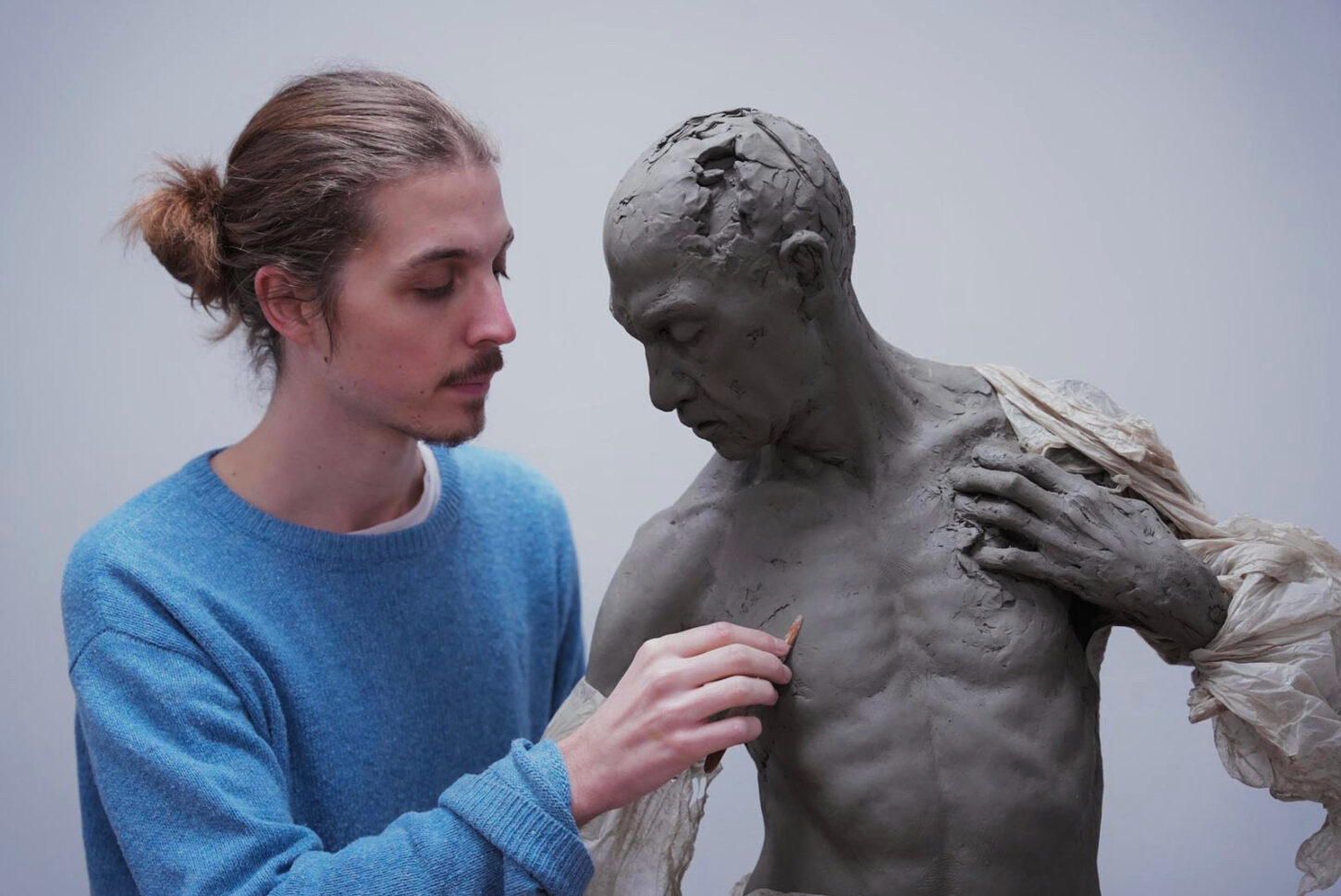
Victor Veber, born in 1994 in Lyon, France, is a sculptor whose work elegantly bridges the gap between classical traditions and contemporary artistry. With a strong foundation in literature, cinema, and philosophy, Veber’s multifaceted education informs his artistic vision, allowing him to create pieces that resonate deeply with both historical and modern themes.
After honing his skills as a stonemason and sculptor on the majestic cathedral of Strasbourg for three years, Veber immersed himself in the techniques of the old masters. This experience not only refined his sculptural abilities but also deepened his appreciation for architectural artistry. His dedication and talent quickly garnered recognition; at just 23 years old, he won the prestigious Museum and Art Society Award in Strasbourg and was invited to showcase his work at the Start European Art Fair.
Veber’s accolades continued to grow as he became the winner of the BMB International Sculpture Competition, solidifying his status as a noteworthy figure in the art world. His exhibitions span several prominent venues, including the Taylor Foundation in Paris and Lyon’s Opera, where he has captivated audiences with his evocative sculptures.
In 2020, seeking to further his artistic education, Veber relocated to Florence, Italy, to study at the Florence Academy of Art. This move marked a significant chapter in his career, allowing him to immerse himself in the rich artistic heritage of the city. By 2022, he took a bold step by co-founding “CORPO,” a sculpture studio in Florence where he currently produces much of his work. This studio serves as a creative hub, fostering collaboration and innovation among artists.
Victor Veber’s recent exhibitions highlight his burgeoning influence within the art community, showcasing his talent across prestigious venues. In 2021, he participated in notable events such as Figurativas at MEAM in Barcelona, Spain, and the Sculptor’s Alliance exhibition titled “On Being” in New York, USA, alongside a display at The Holly Art Gallery in New York. The previous year, he exhibited at the Foundation Taylor in Paris, Galerie Aida in Strasbourg, and the Start’ European Art Fair in Strasbourg, where he also received the Museum and Art Society of Strasbourg Prize. These showcases reflect Veber’s dynamic presence in the contemporary art scene and his commitment to evolving as an artist.
Veber’s philosophy, “Observe Nature in order to reinvent it,” encapsulates his approach to sculpture. He believes that talent can be cultivated through hard work, passion, and dedication. As he states, “I am really inspired by the emotions that the body can convey through dance or corporal expression. I always focus on a personal emotion that I want to express and try to understand how to reproduce this feeling with the pose that the character of my sculpture will take.”
His creative process is meticulous and deeply rooted in research. “It takes a lot of research, so I always start by making small sketches in clay. Once I am happy with the pose that I have found and the emotion, I start thinking about making it on a bigger scale.” He emphasizes the importance of planning: “This takes a lot of planning because you need to build a support that will be resistant enough for the idea that you had on the small scale.” Typically, he hires a life model for the larger version, which allows for precision in anatomy and a realistic rendition of his initial sketches. “This allows me to combine two things that I love: the composition with the smaller scale sculpture, and then have more room to detail and model each shape with the bigger sculpture.”
Veber dedicates several months to complete a large sculpture, with significant effort going into casting and molding once the clay work is done. “It takes several months of hard work to complete a big sculpture. And once the work is done in clay, there is still a lot of work to do to cast the sculpture and to make a mold of the project.”
He prefers working with clay, describing it as “the best way to manage to work for a long time on a sculpture and to make many changes to get the sculpture that you really want to have. It is a really forgiving material to work with, and you can modify endlessly what you are making.” However, he transitions to bronze for larger sculptures, appreciating how the material attracts viewers’ attention: “I think that bronze has a way of attracting the eye of the viewer in a very specific way. It reflects the light very elegantly and draws the attention to the piece.”
Veber believes that materials play a crucial role in how the public perceives his sculptures. “The way the light reflects on the material can change a lot on your work. And you can definitely play with this aspect to also use it to your advantage.” However, he cautions that materials can also pose challenges: “Sometimes the material can also work against you if you’re not careful with it. For example, bronze can be too shiny when it comes out of the foundry, and it can destroy all the nice work of modeling that you did because it is catching too much light and you can’t really see the work anymore.” Therefore, he emphasizes the importance of understanding materials: “I think it is always really important to think ahead and to understand the material you’re using in order to serve your sculpture.”
As he continues to explore the interplay between classical and contemporary forms, Victor Veber is poised to leave an indelible mark on the world of sculpture, inspiring future generations of artists along the way.
Photo credits: The photographs are from the artist’s archive.










